Evelyn Nesbit
Evelyn Nesbit | |
|---|---|
 Käsebier, Gertrude (1903), Portrait (Miss N) (photograph) | |
| Born | Florence Evelyn Nesbit December 25, 1884, or December 25, 1885 Natrona, Pennsylvania, U.S. |
| Died | January 17, 1967 (aged 82) Santa Monica, California, U.S. |
| Other names | Evelyn Nesbit Thaw |
| Occupation | Model, chorus girl, actress |
| Spouse(s) | |
| Children | Russell William Thaw |
Evelyn Nesbit (born Florence Evelyn Nesbit; December 25, 1884 or 1885 – January 17, 1967) was an American artists' model, chorus girl, and actress. She is best known for her years as a young woman in New York City, particularly her involvement in a deadly love triangle between railroad scion Harry Kendall Thaw and architect Stanford White, which resulted in White's murder by Thaw in 1906.
In her day, Nesbit was a famous fashion model, being frequently photographed for mass circulation newspapers, magazine advertisements, souvenir items, and calendars. When in her early teens, she had begun working as an artist's model in Philadelphia. Nesbit continued after her family moved to New York, posing for legitimate artists including James Carroll Beckwith, Frederick S. Church, and notably Charles Dana Gibson, who idealized her as a "Gibson Girl". She was an artists' and fashion model when both fashion photography (as an advertising medium) and the pin-up (as an art genre) were beginning to expand.
Nesbit entered theater, first as a chorus line dancer. She was offered a contract as a featured star, and attracted attention from a variety of wealthy men, including Stanford White, nearly three times her age. In 1905, Nesbit married Harry Thaw, a multi-millionaire with a history of mental instability and abusive behavior. The next year, on June 25, 1906, Thaw shot and killed White at the rooftop theatre of Madison Square Garden.
The press called the resulting court case the "Trial of the Century", and coverage of these well-known figures was sensational. Nesbit testified that White had befriended her and her mother, but had sexually assaulted her when she was unconscious.[1][2][3] Thaw was said to have killed White in retaliation, based on his own obsession with Nesbit.
Nesbit visited Thaw while he was confined to mental asylums. She toured Europe with a dance troupe, and her son, Russell Thaw, was born there. Later she took the boy with her to Hollywood, where she appeared as an actress in numerous silent films. Russell also acted in some of these. Nesbit wrote two memoirs about her life, published in 1914 and 1934. Her son later became a pilot, working as a test pilot for the Douglas Aircraft Company after World War II.
Early life[]
Florence Evelyn Nesbit was born on December 25, 1884, or December 25, 1885, in Natrona, Pennsylvania, a small town near Pittsburgh.[4] In her childhood, she was primarily known as Florence Evelyn. The year of her birth remains unconfirmed, as the local records were later destroyed in a fire and Evelyn said she was unsure of it; some sources have put the year as 1884, some as 1885, and it could have been something else.[5] In later years, Nesbit confirmed that her mother at times added several years to her age as a girl to circumvent child labor laws.[6][7][page needed]
Nesbit was the daughter of Winfield Scott Nesbit and his wife, Evelyn Florence (née McKenzie), and was of Scots-Irish ancestry. Her father was an attorney and her mother was a homemaker. Nesbit later said that she had an especially close relationship with her father, and tried to please him by her accomplishments. Mr. Nesbit encouraged her curiosity and self-confidence. As she loved reading, he chose books for her and set up a small library for her use, consisting of fairy tales, fantasies, and also books regarded typically as of interest to boys only – the "pluck and luck" stories that were popular in that era. When Nesbit showed an interest in music and dance, her father encouraged her to take lessons.[8]
The Nesbit family moved to Pittsburgh around 1893. When Nesbit was about 10, her father died suddenly at age 40, leaving the family penniless. Her family lost their home, and all their possessions were auctioned off to pay outstanding debts. Nesbit's mother was unable to find work using her dressmaking skills, and the family had to depend on the charity of friends and relatives. The family lived as nomads, sharing a single room in a series of boarding houses. Her mother often sent Nesbit's younger brother Howard to live with relatives or family friends for periods of time.[8] Nesbit's mother was eventually given money to rent a house to use as a boardinghouse, in order to have a source of income. She sometimes assigned young Evelyn (aged about 12) to the duty of collecting the rent from boarders. In her 1915 memoir, Nesbit later recalled that, "Mamma was always worried about the rent ... it was too hard a thing for her to actually ask for every week, and it never went smoothly."[9] Nesbit's mother lacked the temperament or savvy to run a boardinghouse, and the venture failed.[9]
Under continuous financial distress which showed no prospect of improvement, Mrs. Nesbit moved to Philadelphia in 1898. A friend had encouraged her, advising that relocation to Philadelphia could open opportunities for her employment as a seamstress. Evelyn and Howard were sent to an aunt and then transferred for care to a family in , whose acquaintance their mother had made some years earlier.[10] Mrs. Nesbit indeed gained a job, not as a seamstress, but as a sales clerk at the fabric counter of Wanamaker's department store. She sent for her children, and both 14-year-old Evelyn and 12-year-old Howard also became Wanamaker employees, working twelve-hour days for six days a week.
It was here that Nesbit had a chance encounter with an artist who was struck by her beauty. She asked Nesbit to pose for a portrait, which her mother agreed to after verifying the artist was a woman. Nesbit sat for five hours and earned one dollar (equivalent to approximately $27.50 in 2016).[11] She was introduced to other artists in the Philadelphia area, and became a favorite model for a group of reputable illustrators, portrait painters, and stained-glass artisans. In later life, Nesbit explained: "When I saw I could earn more money posing as an artist's model than I could at Wanamaker's, I gave my mother no peace until she permitted me to pose for a livelihood."[12]
Modeling career[]

In June 1900, Mrs. Nesbit, leaving her children in the care of others, relocated to New York City to seek work as a seamstress or clothing designer. However, she did not succeed in this competitive world.[13] In November 1900, she finally sent for her children, although she had no work. The family shared a single back room in a building on 22nd Street in Manhattan.[14]
Mrs. Nesbit finally used letters of introduction given by Philadelphia artists, contacting painter James Carroll Beckwith. His primary patron was John Jacob Astor. Beckwith was both a respected painter and instructor of life classes at the Art Students League. He took a protective interest in the young Nesbit, and provided her with letters of introduction to other legitimate artists, such as Frederick S. Church, Herbert Morgan, and Carle J. Blenner.
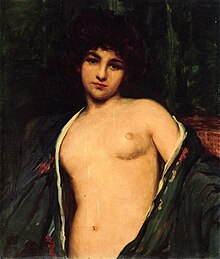
Mrs. Nesbit was forced to take on managing her daughter's career, proving unable to provide either business acumen or guardianship for her daughter. In a later interview with reporters, Mrs. Nesbit maintained: "I never allowed Evelyn to pose in the altogether". Two artworks, one by Church and another by Beckwith in 1901, contradict her statement, as they display a skimpily clad or partially nude Evelyn.[15]

Nesbit became one of the most in-demand artists' models in New York. Photographers Otto Sarony and Rudolf Eickemeyer were among those who worked with her. She was featured on the covers of numerous women's magazines of the period, including Vanity Fair, Harper's Bazaar, The Delineator, Ladies' Home Journal, and Cosmopolitan.[16] She also appeared in fashion advertising for a wide variety of products; and she was also showcased on sheet music and souvenir items – beer trays, tobacco cards, pocket mirrors, postcards, and chromolithographs. Nesbit often posed in vignettes, dressed in various costumes. These photo postcards were known as mignon (sweet, lovely), as their pictorials were of a suggestive sensuality in contrast to the graphic, notorious "French postcards" of the day. She also posed for calendars for Prudential Life Insurance, Coca-Cola, and other corporations.[17] Charles Dana Gibson, one of the country's most renowned artists of the era, used Nesbit as the model for one of his best-known "Gibson Girl" works. Titled Woman: The Eternal Question (c.1903), the portrait features her in profile, with her luxuriant hair forming the shape of a question mark.

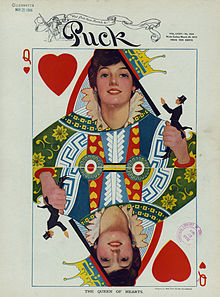

The use of photographs of young women in advertising, referred to as the "live model" style, was just beginning to be widely used and began to supplant illustration. Nesbit modeled for Joel Feder, an early pioneer in fashion photography. She found such assignments less strenuous than working as an artist's model, as posing sessions were shorter. The work was lucrative. With Feder, Nesbit earned $5 for a half-day shoot and $10 for a full day – around $300 per day in 2019 dollars.[18] Eventually, the fees she earned from her modeling career exceeded the combined income which her family had earned at Wanamaker's department store. But the high cost of living in New York strained their finances.[16]
Chorus girl and actress[]
Nesbit became disaffected and bored with the long hours spent in confined environments, maintaining the immobile poses required of a studio model. Her popularity in modeling had attracted the interests of theatrical promoters, some legitimate and some disreputable, who offered her acting opportunities.[19] Nesbit pressed her mother to let her enter the theatre world, and Mrs. Nesbit ultimately agreed to let her daughter try this new way to augment their finances. An interview was arranged for the aspiring performer with John C. Fisher, company manager of the wildly popular play Florodora, then enjoying a long run at the Casino Theatre on Broadway. Mrs. Nesbit's initial objections were softened by the knowledge that some of the girls in the show had managed to marry millionaires. In July 1901, costumed as a "Spanish maiden", Nesbit became a member of the show's chorus line, whose enthusiastic public dubbed them the "Florodora Girls". Billed as "Florence Evelyn", the new chorus girl was called "Flossie the Fuss" by the cast, a nickname which displeased her. She changed her theatrical name to Evelyn Nesbit.[20]
After her stint with Florodora ended, Nesbit sought out other roles. She won a part in The Wild Rose, which had just come to Broadway. After an initial interview with Nesbit, the show's producer, George Lederer, sensed he had discovered a new sensation. He offered her a contract for a year and, more significantly, moved her out of the chorus line and into a position as a featured player – the role of the Gypsy girl "Vashti". The publicity machine began to roll, possibly fueled by the influence of architect Stanford White, and she was hyped in the gossip columns and theatrical periodicals of the day. On May 4, 1902, The New York Herald showcased Nesbit in a two-page article, enhanced by photographs, promoting her rise as a new theatrical light, and recounting her career from model to chorus line to key cast member. "Her Winsome Face to be Seen Only from 8 to 11pm", the newspaper title announced to the public. The press coverage invariably touted her physical charms and potent stage presence; acting skills were rarely mentioned.[21]
Relationships[]
Stanford White[]

As a chorus girl on Broadway in 1901, at the age of 15 or 16, Nesbit was introduced to White by Edna Goodrich,[22] who was also member of the company of Florodora. White, known as "Stanny" by close friends and relatives, was 46 years old.[1] Despite being married with a son, White had an independent social life. He used intermediaries to disarm the girl. Nesbit was initially struck by White's imposing size, which she said "was appalling", and she also said that to her he seemed "terribly old".
White invited Nesbit and Goodrich to lunch at his multi-floor apartment on West 24th Street above the toy store FAO Schwarz, the entrance of which was next to the store's back delivery entrance. In her memoir Prodigal Days (1934), Nesbit described being overwhelmed by White's expensive furnishings and luxurious apartment.[23] He had another male guest about his age, Reginald Ronalds. The luncheon was as extravagant as the setting.[23] Afterward, the party went two flights up to a room decorated in green, where a large, red velvet swing was suspended from the ceiling. Nesbit agreed to sit in it, and White pushed her. The four played spontaneous games involving the swing.[24]
White appeared to be a witty, kind, and generous man. The wealthy socialite was described in newspapers as "masterful", "intense", and "burly yet boyish". He impressed both Nesbit and her mother as an "interesting companion".[25] White sponsored Nesbit, her mother and brother for better living quarters, moving them into a suite at the Wellington Hotel, which he also furnished.[26] White soon won over Mrs. Nesbit; in addition to providing the apartment, he paid for her son, Howard, to attend the Chester Military Academy near Philadelphia. He also persuaded Mrs. Nesbit to take a trip to visit friends in Pittsburgh, assuring her he would watch over her daughter Evelyn.[27]
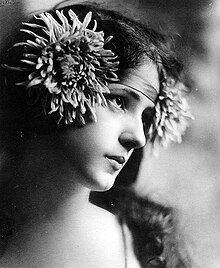

While her mother was out of town, Nesbit and White had dinner and champagne at his apartment, capped by a tour ending at the "mirror room", which was furnished only with a green velvet sofa. After they drank more champagne, Nesbit changed into a yellow satin kimono at White's request. She later said this was her last memory. When Nesbit awoke, she found herself naked in bed next to an also-naked White and saw blood on the sheets, marking the loss of her virginity. [28] Despite the apparent date rape, Nesbit allowed White to be her regular lover and close companion for some time. As their relationship faded, she discovered that he had had affairs with other young women whose names he recorded in a "little black book".
John Barrymore[]
John Barrymore became entranced with Nesbit's performance in The White Rose and attended the show at least a dozen times. The two met at a lavish party given by White, who had invited Barrymore, the brother of his friend, stage actress Ethel Barrymore. In 1902, a romance blossomed between Nesbit and Barrymore, a 21-year-old contemporary who was close to her own age. He was witty and fun-loving, and Nesbit became smitten with him. After an evening out, the couple often returned to Barrymore's apartment, staying until the early-morning hours. Barrymore was casually pursuing a career as illustrator and cartoonist. Although he showed some promise in his chosen field, his salary was small and he behaved irresponsibly with the family money. Nesbit's mother and White considered him an unsuitable match for Nesbit, and both were greatly displeased when they found out about the relationship.[29]
White worked to separate the couple by arranging for Nesbit's enrollment at a boarding school in New Jersey, administered by Mathilda DeMille, mother of film director Cecil B. DeMille.[30] In the presence of both Mrs. Nesbit and White, Barrymore had asked Nesbit to marry him, but she turned him down.
Harry Kendall Thaw[]


Aside from her relationship with Barrymore, Nesbit was involved with other men who vied for her attention. Among those were the polo player James Montgomery "Monte" Waterbury and the young magazine publisher Robert J. Collier. Even as she had these relationships, White still remained a potent presence in Nesbit's life and served as her benefactor.
Nesbit eventually became involved with Harry Kendall Thaw, the son of a Pittsburgh coal and railroad baron. With a history of pronounced mental instability dating to his childhood, Thaw, heir to a $40 million fortune, led a reckless, self-indulgent life.[31] Thaw had attended some 40 performances of The Wild Rose, over nearly a year. Even before he met Nesbit, Thaw had developed a resentment of White, believing that he had blocked Thaw's acceptance in social circles and was a womanizer who preyed on young women.[32] Thaw may have chosen Nesbit because of her relationship with White.[32]
Through an intermediary, Thaw arranged a meeting with Nesbit, introducing himself as "Mr. Munroe". Thaw maintained this subterfuge while giving her items and money. One day he confronted Evelyn and said: "I am not Munroe ... I am Harry Kendall Thaw, of Pittsburgh!"[33] She did not react with such surprise as he had expected; she was already used to attracting the attention of wealthy men.
Trip to Europe[]
In early 1903, while at boarding school, Nesbit underwent emergency surgery. The official diagnosis was acute appendicitis; however, some sources have speculated that she had been pregnant (perhaps by Barrymore) and had an abortion. Evelyn's grandson, Russell Thaw, has said: "I think she went away to have an abortion." However, under oath at Thaw's murder trials, both Barrymore and she denied that she was pregnant or had an abortion.[34]
Thaw became solicitous, ensuring that Nesbit received the best medical care available. He suggested that she should go on a European trip, convincing Nesbit and her mother that this would hasten the young woman's recovery. Evelyn's mother accompanied them for propriety. Thaw created a hectic itinerary and rate of travel. Tensions mounted between mother and daughter, and Mrs. Nesbit insisted on returning to the United States. Thaw took Nesbit alone to Paris, leaving Mrs. Nesbit in London.[35] In Paris, Thaw pressed Evelyn to become his wife, but she refused. Aware of Thaw's obsession with female chastity, she could not accept his marriage proposal without revealing the truth of her relationship with White. Thaw continued to interrogate her, and ultimately Nesbit told him of White's assault. Thaw accused her mother of being an unfit parent.[36]
Thaw and Evelyn continued their travel through Europe. Thaw led her to sites devoted to the cult of virgin martyrdom. In Domrémy, France, the birthplace of Joan of Arc, Thaw wrote in the visitor's book: "she would not have been a virgin if Stanford White had been around."[37] In Austria-Hungary, Thaw took Evelyn to the gothic Katzenstein Castle, where he had the three servants in residence – butler, cook, and maid – kept at one end of the building; while he and Nesbit had isolated quarters at the opposite end.[38] Thaw locked Evelyn in her room, then beat her with a whip and sexually assaulted her over a two-week period. Afterward, he was apologetic and upbeat.[39]
After returning to New York, Nesbit talked to friends about her ordeal. Others shared stories about Thaw and a propensity toward myriad addictive behaviors. Several men told her that Thaw "took morphine" and "he was crazy".[40]
Marriage[]
Although White was still part of her life, Nesbit realized they had no future together. She also knew her relationship with him had already compromised her reputation; if the full extent of their involvement became common knowledge, no respectable man would make her his wife. Nesbit also resented White for failing to tell her about Thaw's excesses and derangement. As a teenager, Nesbit had spent her formative years thrust into the adult society of artists and theatre people; her development had proceeded without the companionship of contemporaries of her own age. Her mother had remarried, and although she had been an inept guardian before, their estrangement was now complete. Nesbit was desperate to escape the poverty which she and her family had long suffered. [41]
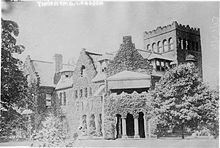
Thaw continued to pursue Nesbit for marriage, promising that following their union he would live the life of a "Benedictine monk". With a perverted sense of justice, and a show of magnanimous charity, Thaw assured Nesbit he had forgiven her for her relationship with White.[42] Nesbit finally consented to marry Thaw. His mother agreed to the marriage, on the condition that Nesbit give up the theatre and modeling, and refrain from talking about her past life.[43]
Nesbit married Thaw on April 4, 1905, in Pittsburgh.[44] For her wedding dress, Thaw chose a black traveling suit decorated with brown trim. Newspapers announced that the new Mrs. Thaw was now the "Mistress of Millions".[45] The two took up residence in the Thaw family home, Lyndhurst, in Pittsburgh. Isolated with Thaw's mother and her like-minded social group of strict Presbyterians, Nesbit became the proverbial bird in a gilded cage. In later years, she said that the Thaws had a shallow value system: "the plane of materialism which finds joy in the little things that do not matter – the appearance of ... [things]".[46]
Nesbit had imagined travel and entertaining, but found that her husband acted as a pious son. Thaw started a campaign to expose White, corresponding with reformer Anthony Comstock, a crusader for moral probity and the expulsion of vice. He became convinced that he was being stalked by members of the notorious Monk Eastman Gang of New York, believing White had hired them. Nesbit later said: "[Thaw] imagined his life was in danger because of the work he was doing in connection with the vigilance societies and the exposures he had made to those societies of the happenings in White's flat."[47] In reality, White, not thought to have been aware of Thaw's animus, considered him a poseur of little consequence, categorizing him as a clown and calling him the "Pennsylvania pug", a reference to Thaw's baby-faced features.
Murder of Stanford White[]
Thaw and Nesbit visited New York in June 1906 before boarding a luxury liner bound for a European holiday. Late that day, Thaw said that he had tickets for them for the premiere of Mam'zelle Champagne, written by Edgar Allan Woolf, at the rooftop theatre of Madison Square Garden. They first stopped at the Cafe Martin for dinner, where they happened to see White, before going to the theatre. Despite the heat, Thaw wore a long black overcoat over his tuxedo and refused to remove it.
At 11:00 pm, as the stage show was coming to a close, White appeared and took his place at a table customarily reserved for him. Spotting his arrival, Thaw approached him several times, each time withdrawing. During the finale, "I Could Love A Million Girls", Thaw produced a pistol, and, from two feet away, fired three shots into White's head and back, killing him instantly.[48] Thaw addressed the crowd, but witness reports varied as to his words. He said (roughly): "I did it because he ruined my wife! He had it coming to him! He took advantage of the girl and then abandoned her! ... You'll never go out with that woman again!"[49] In his book The Murder of Stanford White (2011), Gerald Langford quoted Thaw as saying, "You ruined my life", or, "You ruined my wife."
The crowd initially thought the incident might be a practical joke, but became alarmed upon realizing White was dead. Thaw brandished the pistol and was taken into police custody. Nesbit managed to extricate herself from the ensuing chaos on the Madison Square rooftop. Not wanting to return to their hotel suite, she took refuge for several days in the apartment of a chorus girl friend.[50] Years later, Nesbit said of this time: "A complete numbness of mind and body took possession of me ... I moved like a person in a trance for hours afterward."[51]
Press response[]
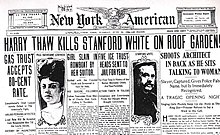
As early as the morning following the murder, news coverage became both chaotic and single-minded, and ground forward with unrelenting momentum. A person, a place, or event, no matter how peripheral to the killing of White, was seized on by reporters and hyped as newsworthy copy.[52] Facts were thin, but sensationalist reportage was plentiful in the heyday of yellow journalism. One week after the killing, the film Rooftop Murder was released for public viewing at the nickelodeon theaters, rushed into production by Thomas Edison.[53]
The hard-boiled male reporters of the yellow press were bolstered by a contingent of female counterparts, christened "Sob Sisters"[54] or "The Pity Patrol."[55] Initially, female spectators were allowed in to witness the proceedings. When the case came to trial, the judge banned women from the courtroom – excepting Thaw family members and the female news reporters there on "legitimate business".[56]
Female reporters wrote human interest pieces, emphasizing sentiment and melodrama.[citation needed] They were less sympathetic to Nesbit than Thaw. Nixola Greeley-Smith wrote of Nesbit: "I think that she was sold to one man [White] and later sold herself to another [Thaw]." In an article titled "The Vivisection of a Woman's Soul", Greeley-Smith described Nesbit's unmaidenly revelations as she testified on the stand: "Before her audience of many hundred men, young Mrs. Thaw was compelled to reveal in all its hideousness every detail of her association with Stanford White after his crime against her."[57]
The rampant interest in the White killing and its key players were used by both the defense and prosecution to feed malleable reporters any "scoops" that would give their respective sides an advantage in the public forum. News coverage dissected all the key players in what was called the "Garden Murder". One florid account keynoted Nesbit's vulnerability: "Her baby beauty proved her undoing. She toddled as innocently into the arms of Satan as an infant into the outstretched arms of parental love ..." Neither was her mother spared the scrutiny of rogue reporting: "She [her mother] knew better. She also knew she was sacrificing her child's soul for money ...."[58]
Church groups lobbied to restrict the media coverage, asking the government to step in as censor. President Theodore Roosevelt decried the newspapers' penchant for printing the "full disgusting particulars" of the trial proceedings. He conferred with the U.S. Postmaster General on the viability of prohibiting the dissemination of such printed matter through the United States mail, and censorship was threatened but never carried out.[59]
White was hounded in death, excoriated as a man and questioned as an architect. The Evening Standard concluded he was "more of an artist than architect"; his work spoke of his "social dissolution". The Nation was also critical: "He adorned many an American mansion with irrelevant plunder."[60] Richard Harding Davis, a war correspondent and reputedly the model for the "Gibson Man", was angered by the yellow press, saying they had distorted the facts about his friend. Vanity Fair published an editorial lambasting White, which prompted Davis to write a rebuttal published in Collier's, in which he attested that White "admired a beautiful woman as he admired every other beautiful thing God has given us; and his delight over one was as keen, as boyish, as grateful over any others."[61]
"Trial of the Century"[]
Defense strategy[]
Thaw's mother was adamant that her son not be stigmatized by clinical insanity. She pressed for the defense to follow a compromise strategy: one of temporary insanity, or what in that era was referred to as a "brainstorm". Acutely conscious that her own family had a history of hereditary insanity, and after years of protecting her son's hidden life, she feared his past would be dragged out into the open, ripe for public scrutiny. Mrs. Thaw proceeded to hire a team of doctors, at a cost of some $500,000, to substantiate that her son's act of homicide constituted a single aberrant act. Nesbit in later years described the determination with which Thaw's family worked to favorably spin his mental deficiency: "the Thaws will put the biggest lunacy experts that money can buy on the stand .... Harry was a madman but they will prove it nicely".[62]
Star witness[]
Again maneuvering her way through the gauntlet of reporters, the curious public, the sketch artists, and photographers enlisted to capture the effect the "harrowing circumstances [had] on her beauty",[63] Nesbit returned to her hotel and the assembled Thaw family. The Thaws may have promised Nesbit a comfortable financial future if she provided testimony at trial favorable to Thaw's case. It was a conditional agreement; if the outcome proved negative, she would receive nothing. The rumored amount of money the Thaws pledged for her cooperation ranged from $25,000 to $1,000,000.[64]
Nesbit's mother remained conspicuously absent throughout her daughter's entire ordeal. Mrs. Nesbit had been cooperating with the prosecution as Thaw's lawyers considered her culpable of prostituting her daughter to White.[65] Nesbit's brother Howard, who had come to regard White as a father figure, blamed her for his death.[66]
Two trials[]
Thaw was tried twice for the killing of White. Nesbit testified at both trials; her appearance on the witness stand was an emotionally tortuous ordeal. In open court, she was forced to detail her relationship with White, including the night when he allegedly raped her. Until then, the sexual assault had been a secret she had guarded at White's request. Other than White, only she and Thaw knew what had happened.[67]
Due to the unusual amount of publicity the case had garnered, the jurors were ordered to be sequestered – the first time in the history of American jurisprudence that such a restriction was ordered.[68] The trial proceedings began on January 23, 1907, and the jury went into deliberation on April 11. After 47 hours, the jurors emerged deadlocked. Seven had voted guilty, and five voted not guilty. Thaw was outraged that the jurors had not recognized it as the act, as he saw it, of one chivalrous man defending innocent womanhood.[69]
The second trial took place from January 1908 through February 1, 1908.[70] At the second trial, Thaw again pleaded temporary insanity. Thaw was found not guilty, on the ground of insanity at the time of the commission of his act. He was sentenced to involuntary commitment for life in the Matteawan State Hospital for the Criminally Insane in Beacon, New York. His wealth allowed him to arrange accommodations for his comfort and be granted privileges not given to the general Matteawan population. Immediately after his confinement, Thaw marshaled the forces of a legal team charged with the mission of having him declared sane; the effort took seven years.[71] The prolonged legal procedures compelled his escape from Matteawan and flight to Canada in 1913; he was extradited to the U.S., but in 1915 was released from custody after being judged sane.
Child[]

Nesbit gave birth to a son, Russell William Thaw, on October 25, 1910, in Berlin, Germany. She always maintained that her son was Thaw's biological child, conceived during a conjugal visit to Thaw while he was confined at Matteawan, although Thaw denied paternity throughout his life.[72]
In 1911, Nesbit reconciled with her mother, who took on the role of caregiver for the child while Nesbit sought out opportunities to support herself and her son.[73] Russell appeared with his mother in at least six films; Threads of Destiny (1914), Redemption (1917), Her Mistake (1918), The Woman Who Gave (1918), I Want to Forget (1918), and The Hidden Woman (1922). He became an accomplished pilot, placing third in the 1935 Bendix Trophy race from Los Angeles to Cleveland, ahead of Amelia Earhart in fifth place.
Later years[]
Throughout the prolonged court proceedings, Nesbit had received financial support from the Thaws. These payments, made to her through the family's attorneys, had been inconsistent and far from generous. After the close of the second trial, the Thaws virtually abandoned her, cutting off all funds. Her grandson, Russell Thaw Jr., recounted a piece of family lore in a 2005 interview with the Los Angeles Times: purportedly, she had received $25,000 from the Thaws after the culmination of the trials. To spite them, she then donated the money to anarchist Emma Goldman, who subsequently turned it over to investigative journalist and political activist John Reed.[74] Nesbit was left to her own resources to provide for herself.[75] She found modest success working in vaudeville and on the silent screen. In 1914, she appeared in Threads of Destiny, produced at the Betzwood studios of film producer Siegmund Lubin.[76]
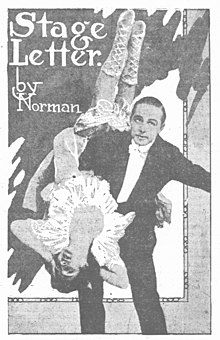
Nesbit divorced Thaw in 1915.[77] In 1916, she married dancer Jack Clifford; the two had worked up a stage act together. Their marriage was not a success; Nesbit seemed unable to start a new life, as the public refused to let her relinquish her past as "the lethal beauty" associated with the "playboy killer". Clifford came to find his wife's notoriety an insurmountable issue, with his own identity subsumed by that of "Mr. Evelyn Nesbit".[77] He left her in 1918, and she divorced him in 1933.
In the 1920s, Nesbit briefly became the proprietor of a tearoom located in the West 50s in Manhattan that has been alleged to have been a speakeasy.[78][79] During this period and well into the 1930s, she struggled with alcoholism and morphine addiction. During the 1930s, she worked on burlesque stages throughout the country, though not as a stripper. In 1939, the then 53-year-old Nesbit told a New York Times reporter: "I wish I were a strip-teaser. I wouldn't have to bother with so many clothes."[74]
Thaw, who as late as 1926 was still keeping his ex-wife under surveillance by private detectives, went to Chicago where Nesbit was hospitalized. He learned that Nesbit, despondent after losing her job dancing, had swallowed a disinfectant in a suicide attempt. The press speculated about the status of their relationship. One newspaper headline on January 8, 1926 said: "Thaw to Visit Chicago: Reconciliation Rumor". In an interview, Thaw said that he had been paying Nesbit $10 a day through an attorney, as a "token of pleasant memories of the past when we were happy".[80] They were photographed together in June 1926. In an interview with the Times, Nesbit said that they were reconciled but they did not continue. Thaw died in 1947; he bequeathed $10,000 to Nesbit from an estate valued at over $1 million.[81]
Nesbit published two memoirs, The Story of My Life (1914)[82] and Prodigal Days (1934).[83]
During World War II, Nesbit lived in Los Angeles, teaching ceramics and sculpting at the Grant Beach School of Arts and Crafts.[74] On June 5, 1945, she was questioned about the murder of Albert Langford, the husband of her friend, Marion Langford. The man was allegedly slain by one of two men whom he would not allow to speak to his wife. The identity of the murderer was never proven.
Nesbit was technical adviser in the 1950s on the movie The Girl in the Red Velvet Swing (1955), about her life and White's murder, for which she was paid $10,000. The movie is considered a highly fictionalized account of her life.[74]
She lived quietly for several years in Northfield, New Jersey, but returned to California.[citation needed]
Death[]
Nesbit died in a nursing home in Santa Monica, California, on January 17, 1967, at the age of 82. She had been a resident there for more than a year.[84][85] She was buried at Holy Cross Cemetery in Culver City, California.[86]
Stage performances[]
- Florodora (1901)
- The Wild Rose (1902)
- Tommy Rot (1902)
Filmography[]
- Threads of Destiny (1914)
- A Lucky Leap (1916)
- Redemption (1917)
- Her Mistake (1918)
- The Woman Who Gave (1918)
- I Want to Forget (1918)
- Woman, Woman! (1919)
- Thou Shalt Not (1919)
- A Fallen Idol (1919)
- My Little Sister (1919)
- The Hidden Woman (1922)
- Broadway Gossip No. 2 (1932 short; as herself)
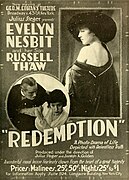
Redemption (1917)

Her Mistake (1918)
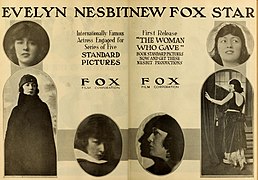
The Woman Who Gave (1918)

A Fallen Idol (1919)
Representation in other media[]
- Author Lucy Maud Montgomery, unaware of Nesbit's notoriety, used a photograph of the young woman, from the Metropolitan Magazine, as the model for the heroine of her book Anne of Green Gables (1908).[87]
- Alexander Theroux's novel Laura Warholic; or, the Sexual Intellectual (2007) features an unreferenced 1901 photograph by Eickemeyer of Nesbit on its cover.
Fiction and film[]
- The Unwritten Law: A Thrilling Drama Based on the Thaw-White Tragedy (1907 film)[88]
- Dalton Trumbo's novel Johnny Got His Gun (1938), has the character Bonni asks the protagonist if she looks like Evelyn Nesbit Thaw, because "all her husbands said she looked just like [her]". (Chapter 14)
- The Girl in the Red Velvet Swing (1955 movie)
- E. L. Doctorow's historical novel Ragtime (1975), features Nesbit as a main character. It was adapted as two works:
- Keith Maillard's long narrative poem, Dementia Americana (1994), refers to Nesbit.
- Claude Chabrol's film, La fille coupée en deux (A Girl Cut in Two) (2007), refers to her.
- Don Nigro's dramatic comedy, My Sweetheart's the Man in the Moon (2010), refers to Nesbt.[89]
- In Boardwalk Empire (2010 HBO television series), the character Gillian is loosely based on Evelyn Nesbit.
References[]
- ^ Jump up to: a b Uruburu 2008, pp. 99, 105: "nearly three times her age, at forty-six".
- ^ Paul, Deborah, Tragic Beauty: The Lost 1914 Memoirs of Evelyn Nesbit, Lulu
- ^ Rayner, Richard (May 11, 2008), "'American Eve' by Paula Uruburu", Los Angeles Times, retrieved June 22, 2015
- ^ Uruburu 2008, pp. 11, 21–22, 378: "Most don't know that her given name was apparently Florence Mary."
- ^ Uruburu 2008, pp. 21–22, 378. The book gives her birth date as December 25, 1884, while also saying "or perhaps 1885, depending on whose version one takes into account." The end notes say, "As for her correct age, the IRS had to rely on the sworn testimony she gave during the murder trial that she was born during 1884 to decide the issue of her receiving Social Security. But Evelyn was never quite sure if that was the correct year and always believed, as she wrote in a number of letters, that she was born in 1885 (which I also believe, given the furor over her turning 18 in December 1903, referred to in various accounts of events)." Uburu gives Nesbit's age at various places in her book (e.g., in the description of her experience in Europe in 1903), but this is sometimes inconsistent with the 1884 birth date.
- ^ Uruburu 2008, p. 61.
- ^ Mooney, Michael Macdonald, Evelyn Nesbit and Stanford White: Love and Death in the Gilded Age, Morrow, 1976
- ^ Jump up to: a b Uruburu 2008, pp. 24–26.
- ^ Jump up to: a b Uruburu 2008, pp. 31–32.
- ^ Uruburu 2008, pp. 34–35.
- ^ "$1 in 1898 → 2016 | Inflation Calculator".
- ^ Uruburu 2008, pp. 40–41.
- ^ Uruburu 2008, p. 56.
- ^ Uruburu 2008, pp. 52–55.
- ^ Uruburu 2008, pp. 58–59.
- ^ Jump up to: a b Uruburu 2008, p. 73.
- ^ Uruburu 2008, pp. 75–76.
- ^ "CPI Inflation Calculator". In 2013 Dollars. May 28, 2019. Retrieved May 28, 2019.
- ^ Uruburu 2008, p. 84.
- ^ Uruburu 2008, pp. 87–88.
- ^ Uruburu 2008, pp. 153–55.
- ^ Nesbit 1934, p. 3.
- ^ Jump up to: a b Nesbit 1934, p. 27.
- ^ Uruburu 2008, p. 107.
- ^ Uruburu 2008, pp. 114–115.
- ^ Uruburu 2008, p. 116.
- ^ Nesbit 1934, p. 37.
- ^ Nesbit 1934, p. 41.
- ^ Uruburu 2008, pp. 165–67.
- ^ Park, Edwards, Pictures of A Tragedy, Smithsonian, retrieved September 23, 2012.
- ^ Uruburu 2008, p. 189.
- ^ Jump up to: a b Uruburu 2008.
- ^ Uruburu 2008, pp. 182–88.
- ^ Rasmussen, Cecilia (December 11, 2005), "Girl in The Red Velvet Swing Longed to Flee Her Past", Los Angeles Times, archived from the original on September 29, 2019, retrieved August 18, 2012.
- ^ Uruburu 2008, pp. 212–13.
- ^ Uruburu 2008, pp. 216–18.
- ^ Uruburu 2008, p. 221.
- ^ Evelyn's Story (affidavit) (Evelyn Nesbit vs. Harry K. Thaw), October 27, 1903, retrieved July 29, 2012[permanent dead link]. This affidavit was introduced at the close of the state's case in the Harry Thaw murder trial.
- ^ Uruburu 2008, p. 225.
- ^ Uruburu 2008, p. 229.
- ^ Uruburu 2008, p. 244.
- ^ Uruburu 2008, pp. 251–52.
- ^ Uruburu 2008, p. 258.
- ^ Marriage License Docket, No. 1196, Series F; Register of Wills; Pittsburgh, Pennsylvania; via FamilySearch.org.
- ^ Uruburu 2008, p. 255.
- ^ Uruburu 2008, p. 256.
- ^ Uruburu 2008, pp. 260–61.
- ^ Uruburu 2008, p. 282.
- ^ "Thaw Murders Stanford White", The New York Times, p. 1, June 26, 1906.
- ^ Uruburu 2008, p. 297.
- ^ Uruburu 2008, p. 284.
- ^ "Mrs Thaw Urged Her Husband On", The Washington Post (an alleged statement to police by Nesbit's former friend, actress Edna McClure), p. 1, July 9, 1906
- ^ Uruburu 2008, p. 301.
- ^ Sob sister video, USC Annenberg, School for Communication and Journalism, August 21, 2012.[dead link]
- ^ Uruburu 2008, p. 318.
- ^ Lutes 2007, p. 74.
- ^ Lutes 2007, pp. 82, 91.
- ^ Uruburu 2008, pp. 318–19.
- ^ Lutes 2007, p. 76.
- ^ Uruburu 2008, pp. 306–7.
- ^ Uruburu 2008, pp. 306-307.
- ^ Uruburu 2008, p. 323.
- ^ Uruburu 2008, p. 289.
- ^ Uruburu 2008, p. 324.
- ^ Lutes 2007, p. 85.
- ^ Uruburu 2008, p. 312.
- ^ Uruburu 2008, pp. 333, 339.
- ^ Uruburu 2008, p. 322.
- ^ Uruburu 2008, p. 354.
- ^ Uruburu 2008, p. 358.
- ^ Uruburu 2008, p. 359.
- ^ Uruburu 2008, pp. 360, 363.
- ^ Uruburu 2008, p. 362.
- ^ Jump up to: a b c d Rasmussen, Cecilia (December 11, 2005). "Girl in Red Velvet Swing Longed to Flee Her Past". Los Angeles Times. Retrieved August 18, 2012..
- ^ Uruburu 2008, pp. 358–61.
- ^ Nesbit 1934, p. 276.
- ^ Jump up to: a b Uruburu 2008, p. 368.
- ^ Freeland, David (September 4, 2010). "Gallagher's and Evelyn Nesbit". Gotham Lost & Found (blog). Retrieved January 1, 2019.[dead link]
- ^ Baker, Lindsay (January 3, 2015). "Evelyn Nesbit: The world's first supermodel". BBC. Retrieved May 29, 2021.
- ^ "Harry K Thaw", Afflictor (old print articles), retrieved July 20, 2012.
- ^ "Evelyn Nesbit". Neo humanism. Retrieved July 20, 2012..
- ^ Nesbit, Evelyn (1914). The Story of My Life (First; hardcover ed.). London: John Long. OCLC 780487288.
- ^ Nesbit 1934.
- ^ "Mrs. Thaw Dies; Early Trial Figure". Los Angeles Times News Service. January 18, 1967. Retrieved October 9, 2010.
Mrs. Thaw, died Tuesday in a convalescent home here. ... After the murder trial she toured Europe with a dancing troupe where a son, Russell Thaw, was born.
[dead link] - ^ "Evelyn Nesbit, 82, Dies In California; Evelyn Nesbit of '06 Thaw Case Dies". The New York Times. Associated Press. January 18, 1967. Retrieved October 9, 2010.
Evelyn Nesbit, the last surviving principal in the sensational Harry K. Thaw-Stanford White murder case of 60 years ago, died in a convalescent home here yesterday, where she had been a patient, for more than a year. She was 82 years old.
- ^ "Evelyn Nesbit (1884-1967) - Find a Grave Memorial".
- ^ "Irene Gammel, Looking for Anne of Green Gables: The Story of L.M. Montgomery and her Literary Classic (New York: St. Martin's Press, 2009)". Youtube.com. January 10, 2008. Retrieved July 30, 2012.
- ^ The Unwritten Law: A Thrilling Drama Based on the Thaw-White Tragedy. IMDb. 1907.
- ^ Nigro, Don (December 2, 2010). My Sweetheart's the Man in the Moon. Samuel French, Inc. ISBN 978-0573642388.
Further reading[]
- Baatz, Simon, The Girl on the Velvet Swing: Sex, Murder, and Madness at the Dawn of the Twentieth Century (New York: Little, Brown, 2018) ISBN 978-0316396653
- Collins, Frederick L. (April 21, 2012). Glamorous Sinners. Literary Licensing, LLC. ISBN 978-1258294854.
- Gammel, Irene (2008). Looking for Anne of Green Gables: How Lucy Maud Montgomery Dreamed Up a Literary Classic (First;hardcover ed.). Key Porter Books. ISBN 978-1552639856.
- Langford, Gerald (1962). The Murder of Stanford White (First; hardcover ed.). Bobbs-Merrill. ASIN B0007DZ4RY.
- Lessard, Suzannah (White's great-granddaughter) (October 1, 1996). The Architect of Desire: Beauty and Danger in the Stanford White Family (First; hardcover ed.). The Dial Press. ISBN 978-0385314459.
- Lutes, Jean Marie (2007). Front Page Girls: Women Journalists in American Culture and Fiction: 1880–1930. Cornell University Press. ISBN 978-0-8014-7412-5.
- Mooney, Michael Macdonald (1976). Evelyn Nesbit and Stanford White: Love and Death in the Gilded Age (1976 ed.). William Morrow. ISBN 9780688030797.
- Nesbit, Evelyn (1914). The Story of My Life (First; hardcover ed.). London: John Long. OCLC 780487288.
- Nesbit, Evelyn (1934). Prodigal Days: The Untold Story of Evelyn Nesbit (First; hardcover ed.). Julian Messner, Inc. ASIN B002672NVE.
- Samuels, Charles (1953). The Girl in the Red Velvet Swing. Fawcett Publications. ASIN B0007EYS3O.
- Thaw, Harry K. (1926). The Traitor: Being the Untampered With, Unrevised Account of the Trial and All That Led to It (Unstated; hardcover ed.). Dorrance & Company/Argus Publisher. ASIN B001KXL6UE.
- Uruburu, Paula (2008). American Eve: Evelyn Nesbit, Stanford White, the Birth of the 'It' Girl, and the Crime of the Century (First; hardcover ed.). Riverhead Books. ISBN 978-1594489938.
External links[]
| Wikimedia Commons has media related to Evelyn Nesbit. |
- Evelyn Nesbit at the Internet Broadway Database

- "Harry Thaw's trial". Urban Sculptures. March 1907. Archived from the original on July 17, 2011.. Scans of a dinner program with jurists' autographs.
- "Murder of the Century". PBS.org. Includes excerpts from Nesbit's autobiographies.
- "The Girl on the Red Velvet Swing". Crime Library. Archived from the original on April 24, 2014.
- Evelyn Nesbit at IMDb
- 1880s births
- 1967 deaths
- People from Harrison Township, Allegheny County, Pennsylvania
- American artists' models
- American female models
- American silent film actresses
- Actresses from Pennsylvania
- American child actresses
- American people of Scotch-Irish descent
- Art occupations
- Thaw family
- Vaudeville performers
- 20th-century American actresses
- People from Northfield, New Jersey
- Burials at Holy Cross Cemetery, Culver City



